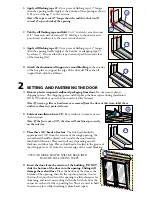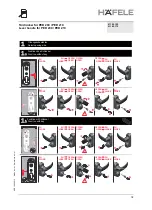
A. Verify the opening is plumb and level.
Note: It is critical that the bottom is level.
YOU WILL NEED TO SUPPLY:
TOOLS REQUIRED:
• Cedar or Impervious shims/spacers (12 to 20)
• 2" galvanized roofing nails (1/4 lb.)
• Closed cell foam backer rod/sealant backer (12 to 30 ft.)
• Pella
®
SmartFlash
™
foil backed butyl window and door
flashing tape or equivalent
• High quality exterior grade polyurethane or silicone sealant
(1 tube per window)
• Great Stuff ™ Window and Door Insulating Foam Sealant
by the Dow Chemical Company or equivalent low pressure
polyurethane window and door foam - DO NOT use high
pressure or latex foams
• Pella aluminum sill support or 2 x 4 wood blocking
• Interior trim and/or jamb extensions (15 to 40 ft.)
• Tape measure
• Level
• Square
• Hammer
• Stapler
• Scissors or utility knife
• Sealant Gun
• Drill
• Screwdrivers
(#2 Phillips & small flat blade)
B. Verify the door will fit the opening. Measure all four
sides of the opening to make sure it is 3/4" larger than
the door in width and 1/2" larger in height. On larger
openings measure the width and height in several places
to ensure the header or studs are not bowed.
Note: 1-1/2" or more of solid wood blocking is required
around the perimeter of the opening. Fix any problems
with the rough opening before proceeding.
C. Cut the water resistive barrier
(1C).
D. Fold the water resistive barrier (1D). Fold side flaps into
the opening and staple to inside wall. Fold top flap up and
temporarily fasten with flashing tape.
1
ROUGH OPENING PREPARATION
SEALANT
SEALANT
4th cut:
Make a 6" cut up from
each top corner at a 45°
angle to allow the water
resistive barrier to be
lapped over the fin at the
head of the door.
1st cut
3rd cut
1C
Water Resistive Barrier
2nd
cut
Interior
1A
Interior
1B
Exterior
1D


























